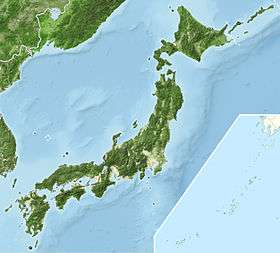1945 Mikawa earthquake
The 1945 Mikawa earthquake (三河地震, Mikawa jishin) occurred off Aichi prefecture, Japan at 03:38 AM on January 13. As it occurred during World War II, information about the disaster was censored,[1] and efforts at keeping the disaster secret hampered relief efforts and contributed to a high death toll.
 | |
 | |
| UTC time | 1945-01-12 18:38:28 |
|---|---|
| ISC event | 898751 |
| USGS-ANSS | ComCat |
| Local date | January 13, 1945 |
| Local time | 03:38 JST [1] |
| Magnitude | 6.8 ML [2] |
| Depth | 11 km (7 mi) |
| Epicenter | 34.7°N 137.1°E [2] |
| Areas affected | Japan |
| Max. intensity | JMA VII [3] |
| Casualties | 2,306 [2] |
Earthquake
The Mikawa earthquake's epicenter was offshore in Mikawa Bay at a depth of eleven kilometers. The city of Tsu recorded a magnitude of 6 on the Richter Scale; however, areas in southern Aichi prefecture were closer to the epicenter, and suffered significant damage.
The earthquake created the Fukozu Fault, named after the village in the middle of the fault trace, in an area adjoining the west of the Tōkaidō Main Line railway between Okazaki and Gamagōri, Aichi Prefecture. The fault's total visible distance is little more than 9 km, but is of great interest to geologists as it has a right-angle bend in its middle part, rather than being straight or at a gentle curve. It is also remarkable in that ground displacement at the fault is up to one meter in places; however, the Tokaido Railway Line, although only 150 meters from the fault line in places, suffered no damage.[4]
Damage
Hardest hit were what is now Hazu District: Nishio city, Kira town, Anjō city, Hekinan city and Gamagōri city. The confirmed death toll was 1,180, with an additional 1,126 missing and 3,866 injured. As the earthquake occurred in the middle of the night, and towards the end of the war when fuel supplies were very low, only two houses were lost to fire, but 7,221 houses were totally destroyed, and 16,555 were severely damaged.
Previous events
Similar large earthquakes have occurred in the same location in 1685 and 1686, and the large 1944 Tōnankai earthquake was also in the same area.
References
- Taniguchi et al. 1988, p. 378
- Utsu, T. R. (2002), "A List of Deadly Earthquakes in the World: 1500–2000", International Handbook of Earthquake & Engineering Seismology, Part A, Volume 81A (First ed.), Academic Press, p. 706, ISBN 978-0124406520
- Taniguchi et al. 1988, p. 384
- Tsuya, H. (1948), The Fukozu Fault. A Remarkable Earthquake Fault formed during the Mikawa Earthquake of January 13, 1945, pp. 59–75, ISSN 0040-8972, archived from the original on 2011-10-06, retrieved 2008-12-23
Sources
- Taniguchi, H.; Miura, F.; Mochizuki, T.; Inada, O. (1988), "Interpretation of damage to houses and casualties relied on a precise evaluation of earthquake ground motions in the epicentral region : The 1945 Mikawa earthquake" (PDF), Natural Disaster Science, Japan Society for Natural Disaster Science, 10 (1): 378–393
External links
- The International Seismological Centre has a bibliography and/or authoritative data for this event.